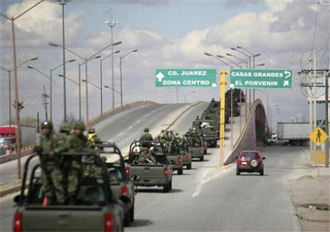
|  |  |  Editorials | Issues Editorials | Issues  
Anti-Drug Drive a Challenge for Mexico: U.S. Report
 David Alexander - Reuters David Alexander - Reuters
go to original
March 02, 2010


| | Soldiers arrive for a change of guard at Ciudad Juarez, March 1, 2010. (Reuters/Alejandro Bringas) |  |
Washington - Anti-drug efforts in Mexico led to thousands of arrests last year but marijuana cultivation increased and traffickers began shifting their routes - and their violence - to Central America, said a U.S. State Department report released on Monday.

The annual International Narcotics Control Strategy Report found that major producers Colombia and Afghanistan slashed their area of land under cultivation for illegal drugs in 2009, but marijuana growth in Mexico rose despite President Felipe Calderon's crackdown on the drug trade.

U.S. Assistant Secretary of State David Johnson said the Obama administration would continue to support Calderon's efforts against Mexican drug traffickers, who are involved in a conflict that has killed 18,000 people since 2006.

"We see a broad commitment to building the institutions of an effective policing system ... in Mexico, and a reform of its judicial institutions," Johnson told a briefing. "And I think that that has very broad support, certainly in our government and we think in Mexico as well."

Calderon's campaign against Mexican drug cartels led to the arrest last year of 36,332 people, including 10 high-profile cartel members, said the congressionally mandated report. But the crackdown prompted drug traffickers to shift some of their routes to countries like Panama and Guatemala.

"With increased counternarcotics efforts in Mexico, drug traffickers are increasing drug transshipment routes through Central America," the report said.

Money laundering is a key challenge for Mexico and the United States. The report said traffickers send $8 billion to $25 billion from the United States to Mexico annually.

"We still have work that we can do and must do on this," Johnson said. "We are dealing with ... millions on a problem that is best expressed with billions."

The report said cannabis cultivation in Mexico grew by 35 percent in 2009 to nearly 30,000 acres.

ERADICATION AND INTERDICTION

By comparison, Colombia, the largest producer of coca, reduced its land under cultivation by about 28 percent to about 295,000 acres, and Afghanistan, the largest producer of poppies, reduced land under cultivation by 22 percent to 300,000 acres.

Coca leaf is used to make cocaine, and poppies are processed into heroin.

The annual report, which reviews foreign governments' efforts to deal with drug trafficking, said Colombia was making "significant progress" in its fight against illicit drugs.

Colombia made "major gains in disrupting the drug trafficking structure," the report said. A growing amount of Colombia's cocaine goes to Europe instead of the United States, it said.

Venezuela has become a preferred route for illicit drugs being shipped out of Colombia, increasing "the level of corruption, crime and violence in Venezuela," the report said.

While Venezuela has cooperated with the United States on some fronts - trying to curb shipment of illegal drugs by sea, for example - it has been less willing to work together to crack down on exports by air from the Colombian border region.

"I haven't seen any effort - certainly any significant efforts - to stop that traffic," Johnson said.

While Colombia's success in curbing cultivation of coca has been through eradication programs, Afghanistan, the largest grower of heroin poppies, is abandoning that tactic.

Instead it is relying on interdiction, strong police enforcement and programs to help farmers develop alternative crops.

"That will only have an impact over time, but it's a battleship that's clearly turned over the course of the last year," Johnson said.

He said Afghans had used the approach successfully themselves in Helmand Province, where expanded government control, police enforcement and help with alternative livelihoods curbed production.

"It ... underscores a point which I think everyone understands," Johnson said. "This is part and parcel of an insecure situation. So where there is greater insecurity regionally in Afghanistan, there's a greater incidence of narcotics production and trafficking."

(Editing by Paul Simao and Mohammad Zargham) |

 |
|  |



